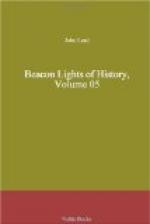So when the Archbishop asked leave of the King to go to Rome, according to custom, William demanded to know to which of these two popes he would apply for his pallium. “To Pope Urban,” was the reply. “But,” said the King, “him I have not acknowledged; and no man in England may acknowledge a pope without my leave.” At first view the matter was a small one comparatively, whether Urban was or was not the true pope. The real point was whether the King of England should accept as pope the man whom the Archbishop recognized, or whether the Archbishop should acknowledge him whom the King had accepted. This could be settled only by a grand council of the nation, to whom the matter should be submitted,—virtually a parliament. This council, demanded by Anselm, met in the royal castle of Rockingham, 1095, composed of nobles, bishops, and abbots. A large majority of the council were in the interests of the King, and the subject at issue was virtually whether the King or the prelate was supreme in spiritual matters,—a point which the Conqueror had ceded to Lanfranc and Hildebrand. This council insulted and worried the primate, and sought to frighten him into submission. But submission was to yield up the liberties of the Church. The intrepid prelate was not prepared for this, and he appealed from the council to the Pope, thereby putting himself in antagonism to the King and a majority of the peers of the realm. The King was exasperated, but foiled, while the council was perplexed. The Bishop of Durham saw no solution but in violence; but violence to the metropolitan was too bold a measure to be seriously entertained. The King hoped that Anselm would resign, as his situation was very unpleasant.




